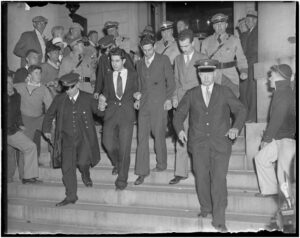
Leslie Jones Collection, Boston Public Library
Leslie Jones Collection
“The Leslie Jones Collection is one of the crown jewels of Digital Commonwealth and the Boston Public Library. Jones was a press photographer who worked for the Boston Herald-Traveler from 1917-1956. During his career, he saved many of his negatives, and by the time he died in 1967, he had kept a collection of nearly 40,000 negatives. The negatives covered decades of his work, including major and minor events in and around the city of Boston.”
From the Boston Public Library’s blog post “Featured Collection: Leslie Jones Collection”, July 13, 2018.
The collection is organized into various series, including a Crime/Police series that includes 324 photos of the notorious Millen-Faber murder case. In 1934, Murton and Irvine Millen and Abraham Faber went on a crime spree which included robbing the Needham Trust Company and murdering two Needham police officers. They were the first to use a machine gun in a bank robbery in Massachusetts. The police acted quickly, and within 18 months of their crimes, the brothers Milen and Faber were tried, convicted and executed. The murder case drew national attention, and Leslie Jones was there to photograph it all.
Crime/Police: Millen-Faber [Murder Case] from the Leslie Jones Collection with Commentary
“While Pretty Boy Floyd, John Dillinger and Bonnie and Clyde terrorized America, Murt and Irv Millen, along with MIT-educated Abe Faber, did their best to contribute to the mayhem by shooting up Massachusetts. Their criminality reached its crescendo shortly after Murt married the Rev. Brighton’s very beautiful teenage daughter, Norma. By the time they were caught in 1934, movie theaters and banks had been robbed and people killed in Fitchburg, Lynn and Needham.”
From a synopsis of the case by Former Massachusetts Appeals Court Judge R. Marc Kantrowitz, based on his reading of the book Tommy Gun Winter (2015) by Nathan Gorenstein. Gorenstein is a Massachusetts native, a veteran journalist, and a distant relative of the Millen brothers.
“In February 2, 1934, at about half past nine o’clock in the forenoon, the three defendants [Murton Millen, Irvine Millen, and Abraham Faber] came to the trust company in a Packard automobile operated by the defendant Murton Millen. Each defendant was armed and one of them wore a mask. They went into the trust company.
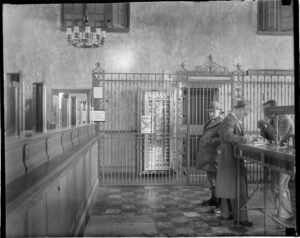
Leslie Jones Collection, Boston Public Library
The defendant Faber carried a shot gun which he fired wounding one Bartholomew, who was employed by the company as a guard. The defendant Irving Millen fired an automatic pistol while taking money from the cashier’s cage. The defendants took from the trust company about $15,000. An employee of the trust company caused an alarm bell outside the building to ring, and Officer McLeod, who was on duty near the building and heard the alarm, hastened toward the bank. Murton Millen, armed with a machine gun, fired through a window and shot McLeod, three bullets striking him and causing his death within a few hours. The defendants then entered the automobile, which was operated by Murton Millen, and drove away, compelling Arnold Mackintosh, the treasurer of the bank, and John D. Riordan, the teller, to go with them, standing on the running board. After going a short distance Riordan jumped off, and when he did so was fired upon by the defendants.
As a result of a telephone call one Salamone, a lieutenant of the fire department, was talking with Officer Haddock, and the Packard automobile operated by Murton Millen, in which the two other defendants were riding, came down the highway in front of the Needham fire station going in the direction of Boston; when in the vicinity of the fire station the machine gun was fired by Murton Millen, two of the bullets striking Haddock and killing him, and other bullets striking one Coughlin, a member of the Needham fire department, who was standing nearby. The defendants continued on for several hundred yards beyond the fire station when the automobile slowed down and Mackintosh Jumped from the running board. On February 7, 1934, this Packard automobile was found in the town of Norwood. It had been partly burned and the number plates had been removed, and there was other evidence that an attempt had been made to destroy its identity.
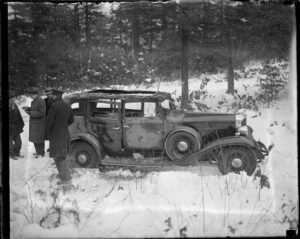
Leslie Jones Collection, Boston Public Library
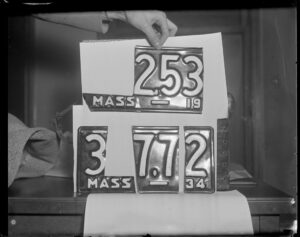
Leslie Jones Collection, Boston Public Library
The storage battery showed that it bad been recently repaired. There was evidence introduced at the trial that the defendants Millen previously had possession of this battery and that they had taken it to a certain shop to be repaired. As a result of this information the police learned that Murton Millen was living in Boston.”
From a synopsis of the crime in Commonwealth vs. Murton Millen & Others, 289 Mass. 441 (1934-1935), a judgment in an unsuccessful appeal to the Massachusetts Supreme Judicial Court of the Millen and Faber trial held in Norfolk County.
“[The Millen/Faber] trial lasted longer than any other murder-one in the history of the commonwealth. During the proceedings, the notorious Bonnie and Clyde were shot dead in Louisiana. The Boston press reported it below the ongoing Millen-Faber proceedings. After 37 days, the all-male sequestered jurors, who had been allowed to shower once a week, got the case. It took them six hours to render a verdict. Guilty. The sentence: death. While awaiting their fate, Murt and Irv, with help from the outside, tried a daring escape that failed. On June 7, 1935, the brothers and Abe sat in the electric chair. It marked the first time two brothers were put to death on the same evening.”
From a synopsis of the case by Former Massachusetts Appeals Court Judge R. Marc Kantrowitz, based on the book Tommy Gun Winter (2015) by Nathan Gorenstein.
The Gun and Early Attempts at Gun Control
“The [Thompson] machine gun used in the first machine-gun bank robbery and murder in Massachusetts yesterday in Needham is that stolen from the State Police, in the opinion of experts.”
From “Bold Gunmen First to Employ Machine Gun in This State Staging Bank Holdup”, The Boston Daily Globe, Feb. 3, 1934, page 1.
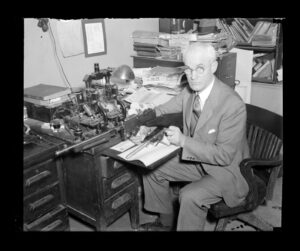
Leslie Jones Collection, Boston Public Library
“An amendment to the Firearms law which would prohibit the sale of shotguns, rifles and other firearms without a license, was drafted yesterday by Police Commissioner Joseph J. Leonard. . . The amendment is a direct development of the futile attempt of Edward C. Frye of Dorchester to free the Millen brothers from Dedham Jail Thursday morning. Frye bought a shotgun on Hanover st and later fired it through a Dedham Jail window peppering Irving Millen with pellets. Under the present law a person may buy a shotgun or rifle without being questioned.”
From “Would Tighten Firearms Law”, The Boston Globe, June 12, 1935, page 20.
Digital Commonwealth provides access to Boston Public Library’s Leslie Jones Collection
The Leslie Jones Collection of photographic images from roughly the first half of the twentieth century has been digitized by the Boston Public Library, and made available to the public through Digital Commonwealth’s website. The nearly forty thousand pictures cover a wide variety of subjects. Strengths of the collection include images of baseball and of maritime activities, as well as photographic documentation of criminal trials. We can use a photo-journalist’s eye to reconstruct the story of the Millen brothers and Abe Faber’s crime spree in 1934 and gain a deeper understanding of the events that shaped our history.
